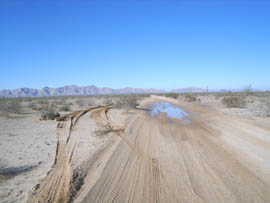Environmental groups call on Border Patrol to reduce off-road damage

 By Gerald Bourguet Cronkite News
By Gerald Bourguet Cronkite News
Organ Pipe Cactus National Monument
• Contains 26 species of cactus and the namesake organ pipe cactus, which is rare in the U.S.
• Became a national monument in 1937
Cabeza Prieta National Wildlife Refuge
• Home to the Sonoran pronghorn, an endangered species that is the fastest land mammal in North America.
• Home to as many as 420 plant species and 300 kinds of wildlife.
TUCSON – Border Patrol off-road vehicles used to catch illegal immigrants and drug smugglers are damaging the landscapes of two ecologically sensitive areas of southern Arizona, environmental groups contend.
The Sierra Club and Tucson-based Center for Biological Diversity released a short video showing damage from ATVs at Organ Pipe Cactus National Monument and Cabeza Prieta National Wildlife Refuge and calling for better training of officers who ride them.
One of the groups’ concerns is damage to cryptobiotic soil, a crust containing tiny organisms that is crucial to cactuses and native grasses. When field agents drive off the road and crush the cryptobiotic soil into dust, they create tracks that will last for hundreds of years.
On existing roads, officers who drive too fast create a silty dust that no one wants to drive through, which leads to more off-roading.
According to a 2011 report from the Department of the Interior, there are approximately 8,000 miles of undocumented tracks at Cabeza Prieta alone.
“These places aren’t just important to our environmental groups,” said Dan Millis, the borderlands campaign organizer for the Grand Canyon chapter of the Sierra Club. “They’re important to America and we hope they’ll continue to be appreciated and loved for years to come.”
The Organ Pipe cactus, after which the national monument is named, is one kind of vegetation threatened by the destruction of cryptobiotic soil, the groups said.
According to Cyndi Tuell, a conservation advocate for the Center for Biological Diversity, the tracks
also harm vegetation and wildlife by altering the flow of water.
“There’s a dust problem when they drive off-road, so water doesn’t infiltrate the soil the way it should,” she said. “Water used to flow across the landscape in a different way, and areas where animals relied on water no longer have it because it’s flowing into the road like a river, which doesn’t allow for vegetation.”
The groups said the endangered Sonoran pronghorn in Organ Pipe is harmed by loss of vegetation and is easily scared off by the sound of ATVs and trucks.
Shelton McKenzie, the congressional affairs and border community liaison for the communications division of the Tucson sector of the Border Patrol, defended Customs and Border Protection in an email response.
“The preservation of our valuable natural and cultural resources is of great importance to CBP, and we are fully engaged in efforts that consider environmental impact as we work to secure our nation’s borders,” he wrote. “The Border Patrol complies with all established laws and reporting procedures in place at national parks and protected wilderness areas.
“We are committed to responsible environmental stewardship and look forward to working with interested parties and border residents to accomplish our mission while preserving the environment.”
Millis, with the Sierra Club, criticized the Border Patrol’s practice of dragging tires across a major dirt road through both areas to smooth dirt, making it easier to spot fresh tracks. He said the so-called tire drags have widened historic El Camino del Diablo, which was once little more than a jeep trail.
“None of these things are earthshaking disasters, but cumulatively over time they will change these areas we’ve set aside as protected so our children can enjoy them,” he said.
The groups offered to help the U.S. Department of Homeland Security update the Border Patrol’s online training program on protecting the environment to make it more site-specific.
“A lot of the new agents coming in aren’t from a desert landscape and they see it as a barren wasteland,” said Tuell with the Center for Biological Diversity. “They don’t see the species that are being affected there, so we’d like their training to be much more targeted so they understand why off-roading every day needs to stop.”
Tuell said the groups aren’t trying to hinder Border Patrol operations.
“All we’re asking them to do is to stop off-roading on a daily basis when they’re not in hot pursuit,” she said.
Millis said the fragile desert ecosystem would greatly benefit if the Border Patrol simply moved away from the bases at Organ Pipe and Cabeza Prieta.
“They should move their operations closer to the border and serve as an actual deterrent instead of their strategy right now, which is sitting back 16 miles from the border, waiting for people to cross and trying to set up an ambush,” he said. “They’re using our national treasures as a net to catch people and that’s totally unacceptable.”














